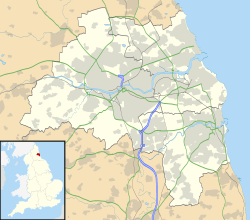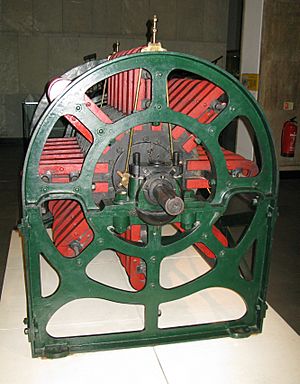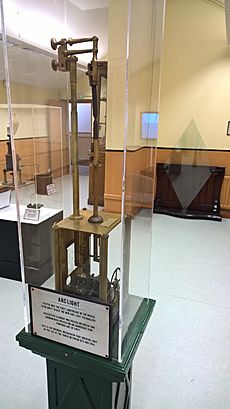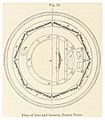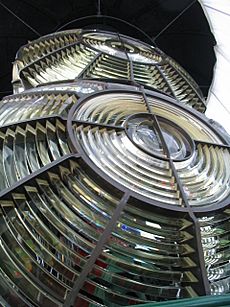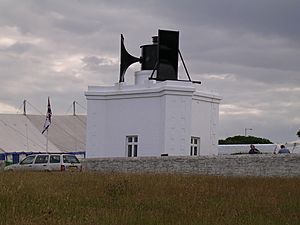Souter Lighthouse facts for kids
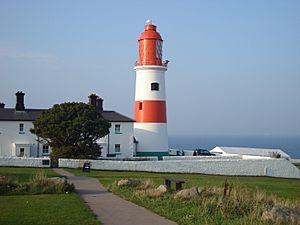 |
|
| Souter Lighthouse | |
|
|
|
| Location | Marsden Tyne and Wear England |
|---|---|
| Coordinates | 54°58′14″N 1°21′51″W / 54.970503°N 1.364100°W |
| Year first constructed | 1871 |
| Deactivated | 1988 |
| Construction | brick tower |
| Tower shape | cylindrical tower with balcony and lantern |
| Markings / pattern | white tower with a horizontal red band, red lantern |
| Height | 77 ft (23 m) |
| Original lens | 2nd & 3rd order revolving catadioptric |
| Current lens | revolving 1st order bi-form catadioptric |
| Range | 26 nmi (48 km; 30 mi) |
| Characteristic | Fl R 5s. |
| Fog signal | One blast every 30s |
| Admiralty number | A2694 |
| ARLHS number | ENG-127 |
Souter Lighthouse is a lighthouse located in the village of Marsden in South Shields, Tyne & Wear, England. Souter was the first lighthouse in the world to be actually designed and built specifically to use alternating electric current, the most advanced lighthouse technology of its day. First lit in the 1870s, Souter was described at the time as 'without doubt one of the most powerful lights in the world'.
Contents
Location
The lighthouse is located on Lizard Point, but takes its name from Souter Point, which is located a mile to the south. This was the intended site for the lighthouse, but it was felt that Lizard Point offered better visibility, as the cliffs there are higher, so the lighthouse was built there instead. The Souter Lighthouse name was retained in order to avoid confusion with the then recently built Lizard Lighthouse in Cornwall.
Souter Lighthouse is approximately three miles south of the mouth of the River Tyne. Some four miles or so to the north of the mouth of the Tyne is a sister Victorian lighthouse, St Mary's Lighthouse, on St Mary's Island. This has now been decommissioned, but is open to visitors. St Mary's Lighthouse can be seen with the naked eye from the top of Souter Lighthouse.
History
The lighthouse was a much-needed aid to navigation due to the number of wrecks on the dangerous reefs of Whitburn Steel which lay directly under the water in the surrounding area. In one year alone – 1860 – there were 20 shipwrecks. This contributed to making this coastline the most dangerous in the country, with an average of around 44 shipwrecks per every mile of coastline.
19th century
Construction
Designed by James Douglass it was opened in 1871, with construction supervised by civil engineer Henry Norris for Trinity House. The contract for building the lighthouse and keeper's cottage was reported in March 1869 as being £8,000 and was awarded to the local firm of James Todd, after complaints that local builders had not had the opportunity to reply to tender as it had not been advertised locally. The foundation stone was ceremonially laid by Admiral Collinson's sister on 9 June 1869. After completing this project Douglass and Norris moved on to the building of Hartland Point Lighthouse in Devon.
Electricity
Trinity House had carried out an extensive testing and selection process over five years and included comparison with oil lights and examination of equipment in Britain and France.
The 800,000 candle power light was generated using carbon arcs and not an incandescent light bulb, and could be seen for up to 26 miles. The optics were designed and built by James Chance in 1870. The main lens array consisted of a third-order fixed catadioptric optic surrounded by a revolving assembly of eight vertical condensing-prisms which produced one flash every minute.
In addition to the main light a red/white sector light shone from a window in the tower below the lantern, to highlight hazardous rocks to the south; it was powered using light diverted (through a set of mirrors and lenses) from the landward side of the main arc lamp.
Carbon arc lights for lighthouses were pioneered by Professor Frederick Hale Holmes with experiments in (1857-60) at Blackwell and South Foreland Lighthouse off the Kent coast (described in a lecture by Michael Faraday at the Royal Institution) and a test installation at Dungeness in 1862 and complete installation at Souter in 1870. Electricity was provided by two of Holmes' own magneto electric generators for which he took out a series of patents during those years. One of the Holmes generators built in 1867 and used at Souter is now on display at the Science Museum, London. The generators were driven by one of a pair of 3 hp steam engines, located in the engine-house, which also drove an air-pump to feed the pressure tank of a foghorn. (The engines were worked alternately: one week on, one week off.)
Charts and engineering (1875)
20th century
In 1914 the pioneering electric light at Souter was replaced with more conventional oil lamps. At the same time Chance Brothers provided a new, much larger bi-form first-order catadioptric revolving optic, which remains in situ in the tower; as a bi-form lens it is double-height, containing two lamps, one above the other. (A separate lamp was used for the sector light, lower down in the tower).
In 1952 the lighthouse was again converted to run on (mains) electric power. The mechanism which caused the optic (lens array) to revolve was driven by clockwork until 1983.
Souter Lighthouse was decommissioned in 1988, but continued to serve as a radio navigation beacon up until 1999 when it was finally closed.
Present day
As Souter was never automated, it remains much in its original operational state except for updates during its lifespan to its lantern and electrical apparatus.
Today the decommissioned Souter lighthouse is owned by the National Trust and open to the public; the engine room, light tower and keeper's living quarters are all on view. There is also an outdoor play area, Trusty Club and indoor activities to accommodate young visitors. Two of the former lighthouse keepers' cottages are used as National Trust holiday cottages. The lighthouse is said to be haunted, and has even featured on British TV's Most Haunted ghost-hunting programme.
Foghorn
The original fog signal at Souter was a single Holmes-designed reeds, housed in a foghorn house to the east of the lighthouse tower; it sounded one blast every 45 seconds and was soon replaced by a pair of twin horns facing out to sea, angled north-east and south-east. Compressed air was piped to the foghorn from the engine room alongside the lighthouse, where the air compressor was driven by a common drive shaft from the engines powering the magnetos. A siren replaced the reeds in February 1879. The horns were superseded by twin Rayleigh trumpets in 1919, when a more powerful siren was installed; the foghorn house was remodelled at the seaward corners to accommodate them. The siren signal was a 5-second sound of 480 Hz every 5 minutes.
The current pair of exponential horns dates from 1953, when a Stone Chance diaphone signal was installed. This produced a five-second blast every 30 seconds in poor weather, up until 1988 when Souter Lighthouse was decommissioned by Trinity House. The diaphone remains in working order and is sounded regularly for visitors throughout the year.


